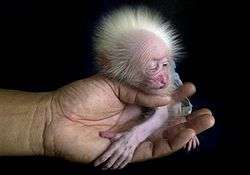Catarrhini
| Catarrhines Temporal range: Late Eocene–Holocene | |
|---|---|
 | |
| An infant stump-tailed macaque and an adult human hand | |
| Scientific classification | |
| Kingdom: | Animalia |
| Phylum: | Chordata |
| Class: | Mammalia |
| Order: | Primates |
| Suborder: | Haplorhini |
| Infraorder: | Simiiformes |
| Parvorder: | Catarrhini É. Geoffroy, 1812[1] |
| Superfamilies | |
|
Cercopithecoidea (Old World monkeys) | |
Catarrhini is one of the two subdivisions of the simians, the other being the plathyrrhine (New World monkeys). The Catarrhini contains the Old World monkeys and the apes; the latter of which are in turn further divided into the lesser apes or gibbons and the great apes, consisting of the orangutans, gorillas, chimpanzees, and humans. The Catarrhine are all native to Africa and Asia. Members of this parvorder are called catarrhines.
Description
The technical distinction between the New World platyrrhines and Old World catarrhines is the shape of their noses. The platyrrhines (from Ancient Greek platu-, "flat", and rhin-, "nose") have nostrils which face sideways. The catarrhines (from Ancient Greek kata-, "down", and rhin-, "nose") have nostrils that face downwards. Catarrhines also never have prehensile tails, and have flat fingernails and toenails, a tubular ectotympanic (ear bone), and eight, not 12, premolars, giving them a dental formula of: 2.1.2.32.1.2.3.[2]
Most catarrhine species show considerable sexual dimorphism and do not form a pair bond. Most, but not all, species live in social groups. Like the platyrrhines, the catarrhines are generally diurnal,[2] and have grasping hands and (with the exception of bipedal humans) grasping feet.
The apes – in both traditional and phylogenic nomenclature – are exclusively catarrhine species. In traditional usage, ape describes any tailless, larger, and more typically ground-dwelling species of catarrhine. "Ape" may be found as part of the common name of such species, such as the Barbary ape. In phylogenic usage, the term ape applies only to the superfamily Hominoidea. This grouping comprises the two families Hylobatidae, the lesser apes or gibbons, and Hominidae, the great apes, including orangutans, gorillas, chimpanzees, Homo, and related extinct genera, such as the prehuman australopithecines and the giant orangutan relative Gigantopithecus.
Classification and evolution
The apes and Old World monkeys split from their New World monkey kin about 35 million years ago (Mya). The major catarrhine division occurred about 25 Mya, with the gibbons separating from the great apes (including humans) about 15-19 Mya.[3]
The distinction between apes and monkeys is complicated by the traditional paraphyly of monkeys: Apes emerged as a sister group of Old World Monkeys in the catarrhines, which are a sister group of New World Monkeys. Therefore, cladistically, apes, catarrhines and related contempory extinct groups such as Parapithecidaea are monkeys as well, for any consistent definition of "monkey". "Old World Monkey" may also legitimately be taken to be meant to include all the catarrhines, including apes and extinct species such as Aegyptopithecus,[4] in which case the apes, Cercopithecoidea and Aegyptopithecus emerged within the Old World Monkeys.
- Order Primates[1]
- Suborder Strepsirrhini: lemurs, lorises, etc.
- Suborder Haplorhini: tarsiers + monkeys, including apes
- Infraorder Tarsiiformes
- Family Tarsiidae: tarsiers
- Infraorder Simiiformes: simians, or higher primates
- Parvorder Catarrhini
- Superfamily Cercopithecoidea
- Family Cercopithecidae: Old World monkeys
- Superfamily †Propliopithecoidea
- Family †Propliopithecidae (includes Aegyptopithecus)
- Superfamily †Saadanioidea
- Family †Saadaniidae
- Superfamily Hominoidea
- Family Hylobatidae: gibbons
- Family Hominidae: great apes (including humans)
- Superfamily Cercopithecoidea
- Parvorder Platyrrhini: New World monkeys
- Parvorder Catarrhini
- Infraorder Tarsiiformes
Late Asian catarrhines
In May 2005, three new primate fossils were discovered in the Bugti Hills of Pakistan. Discovered in 2001, the early primate Bugtilemur led to the assumption that lemurs came from Asia, not Africa.
The three primates called Bugtipithecus inexpectans, Phileosimias kamali, and Phileosimias brahuiorum all date back to the Oligocene some 30 Mya – when monkeys dominated only Africa. These were small lemur-like catarrhines that prospered in an ancient tropical rainforest. Possibly these Asian catarrhines led nowhere in evolution, a side branch from Eosimias. Other possible new catarrhine fossils have been uncovered in China, Thailand, and Burma.[5]
References
- 1 2 Groves, C.P. (2005). "ORDER PRIMATES". In Wilson, D.E.; Reeder, D.M. Mammal Species of the World: A Taxonomic and Geographic Reference (3rd ed.). Johns Hopkins University Press. pp. 111–184. ISBN 978-0-8018-8221-0. OCLC 62265494.
- 1 2 "Catarrhini Infraorder". ChimpanZoo (The Jane Goodall Institute). Retrieved January 2010. Check date values in:
|access-date=(help) - ↑ Carlos G. Schrago; Claudia A. M. Russo (2003-06-27). "Timing the Origin of New World Monkeys". Molecular Biology and Evolution. Oxford Journals. Retrieved 2010-08-21.
- ↑ "Monkeys and apes".
- ↑ Marivaux; et al. (June 2005). "Anthropoid primates from the Oligocene of Pakistan (Bugti Hills): Data on early anthropoid evolution and biogeography". PNAS. 102 (24): 8436–41. doi:10.1073/pnas.0503469102. PMC 1150860
 . PMID 15937103. (Full text PDF)
. PMID 15937103. (Full text PDF)
- Sellers, Bill (2000-10-20). "Primate Evolution" (PDF). Retrieved 2010-08-21.
- Disotell T. R.; Noviello C. M.; Raaum R. L.; Sterner K. N.; Stewart C. (2005). "Catarrhine primate divergence dates estimated from complete mitochondrial genomes: concordance with fossil and nuclear DNA evidence". J. Hum. Evol. 48 (3): 237–257. doi:10.1016/j.jhevol.2004.11.007. PMID 15737392.
| Wikispecies has information related to: Catarrhini |
| Wikinews has related news: Researchers discover last common ancestor of apes and monkeys |